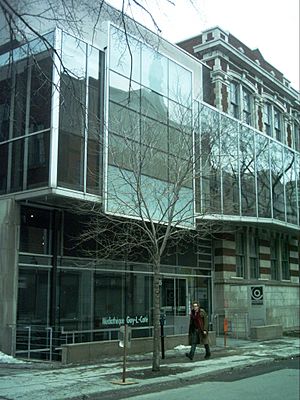Cinémathèque québécoise facts for kids
The Cinémathèque québécoise is a special place in Montreal, Quebec, Canada. It's like a big library and museum for movies and TV shows. Its main job is to collect, protect, and share films, TV programs, and everything related to them. This includes old cameras, scripts, photos, and even costumes!
The Cinémathèque has a huge collection: over 35,000 films, 25,000 TV shows, and hundreds of thousands of photos and posters. It also has a movie theater where you can watch rare and interesting films and videos. You can find it at 355, boulevard De Maisonneuve East, in a part of the city called the Quartier Latin.
Contents
How It Started
The Cinémathèque began in 1963. It was first called "Connaissance du cinéma," then quickly changed its name to "Cinémathèque canadienne."
In 1971, it was renamed the Cinémathèque québécoise, which is its name today. The building where it is located was made much bigger and better between 1994 and 1997. It even won awards for its cool design!
In 2017, the Cinémathèque québécoise worked with other film groups across Canada. They put together a special showing of 150 important Canadian films.
What the Cinémathèque Does
Its Main Goal
The Cinémathèque québécoise is a nonprofit organization. This means it's not trying to make money, but rather to help people. Its main goal is to protect and share the history of movies and TV from Quebec. It also focuses on animated films from all over the world.
For these two areas, the Cinémathèque collects, organizes, protects, and shows films and TV shows. It also gathers all the things that help us understand them better. This includes scripts, photos, old newspaper articles, and historical information.
The Cinémathèque also collects important films from Canada and around the world. It wants to make sure these films are available for everyone to learn from and enjoy.
Amazing Collections
How the Collections Grew
The Cinémathèque's collections really started to grow in 1967. First, there was a special event about Canadian films. The copies of films shown there became the first part of the Cinémathèque's collection. A few months later, a big show of animated films from around the world happened at the 1967 International and Universal Exposition. For this event, the Cinémathèque got 250 old silent animated films. These films became the start of its amazing animation collection.
In 1968, the Cinémathèque made a deal with the Canadian Broadcasting Corporation. This meant that animated films made by the CBC would be given to the Cinémathèque. They also received important documents like drawings and soundtracks.
In 1969, the Cinémathèque received a huge collection of books and articles from Canadian filmmaker Guy L. Coté. This collection was first kept at another library so people could use it. In 1981, it moved to the Cinémathèque building and became part of the Médiathèque Guy-L.-Coté.
During the 1970s, the Cinémathèque worked to teach filmmakers in Quebec how important it was to save their films and related items. By 1974, they had thousands of photos related to films from around the world, Canada, and animated movies.
The 1980s were a time of big growth for the Cinémathèque. Hundreds of films were added every month! When the Cinémathèque moved to a new building in 1982, the National Film Board of Canada gave them most of the animated films they had made. The Cinémathèque also started collecting thousands of scripts.
Between 1984 and 1988, many important people and companies donated their photo collections to the Cinémathèque.
In 1992, a technician from Radio Canada, Camille Moulatlet, made a very special donation. He gave 63 cameras and 200 projectors, which greatly added to the Cinémathèque's collection of old film equipment.
In 1994, the Cinémathèque officially decided to also collect television programs. They started getting shows made by independent producers.
In the late 1990s, the Cinémathèque became more specific about what it would accept. They decided to only take donations, not just temporary loans. They also focused on collecting original film negatives and other important production materials.
Between 2003 and 2007, Moses Znaimer donated 289 old television sets. This was a big moment for the Cinémathèque's collection of equipment.
In 2008, the Cinémathèque's mission grew even more to include other new types of media. Three years later, in 2011, they received the research and documentation center from the Daniel Langlois Foundation.
See also
 In Spanish: Cinemateca Quebequense para niños
In Spanish: Cinemateca Quebequense para niños


